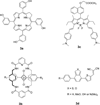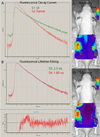Near-infrared molecular probes for in vivo imaging
- PMID: 22470154
- PMCID: PMC3334312
- DOI: 10.1002/0471142956.cy1227s60
Near-infrared molecular probes for in vivo imaging
Abstract
Cellular and tissue imaging in the near-infrared (NIR) wavelengths between 700 and 900 nm is advantageous for in vivo imaging because of the low absorption of biological molecules in this region. This unit presents protocols for small animal imaging using planar and fluorescence lifetime imaging techniques. Included is an overview of NIR fluorescence imaging of cells and small animals using NIR organic fluorophores, nanoparticles, and multimodal imaging probes. The development, advantages, and application of NIR fluorescent probes that have been used for in vivo imaging are also summarized. The use of NIR agents in conjunction with visible dyes and considerations in selecting imaging agents are discussed. We conclude with practical considerations for the use of these dyes in cell and small animal imaging applications.
Figures








References
-
- Achilefu S, Bloch S, Markiewicz MA, Zhong TX, Ye YP, Dorshow RB, Chance B, Liang KX. Synergistic effects of light-emitting probes and peptides for targeting and monitoring integrin expression. Proceedings of the National Academy of Sciences of the United States of America. 2005;102:7976–7981. - PMC - PubMed
-
- Achilefu S, Dorshow RB, Bugaj JE, Rajagopalan R. Novel receptor-targeted fluorescent contrast agents for in vivo tumor imaging. Invest Radiol. 2000;35:479–485. - PubMed
Publication types
MeSH terms
Substances
Grants and funding
LinkOut - more resources
Full Text Sources
Other Literature Sources
Medical
Miscellaneous

